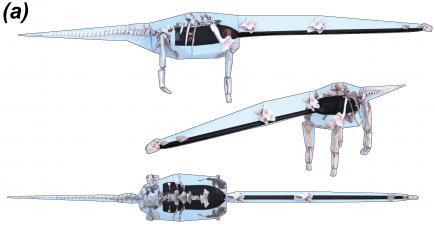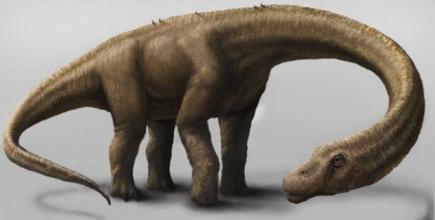Either veggie diets really do the trick or this dinosaur – estimated to weigh the equivalent of about five double decker buses – has been hitting the prehistoric gym hard!
The herbivorous Dreadnoughtus was once thought to have weighed 60,000kg but it appears those estimations were wrong and the dinosaur may have weighed a mere 38,000kg, according to the University of Manchester.
Researches from the university along with a team of scientists from University of Liverpool, Imperial College London and Liverpool John Moores used a computer reconstruction of the dino dieter to estimate the new body mass.

IF ONLY DIETS WERE THAT EASY! Dreadnoughtus lost almost half its body weight thanks to new reconstruction programme
This was done by fitting simple shapes to the digital model of its skeleton and calculating its volume, which was then converted into a body mass using data collected from similar modern animals.
With this technique scientists were able to predict that the 26 meter long herbivore would have weighed a maximum of 38,000kg.
The team from the US which originally wrote the paper on Dreadnoughtus’ theorised that the dinosaur weighted 59,300kg.
Which was calculated based on the circumference of the fossils long leg bones, derived from current living four-legged animals.
Co-author Dr Charlotte Brassy, from the Faculty of Life Sciences at UoM, said: “For Dreadnoughtus to have reached the originally estimated size it would have needed a much higher body density.
“Or much more soft tissue than you find in living four-legged animals.”
Leader of the paper, Dr Peter Falkingham from LJMU added: “The original method used to calculate the mass of the animal has been used successfully on many specimens.
“The highest estimates produced for this particular giant, however, didn’t quite match up.”
Dreadnoughtus was found in Patagonia in 2005 and the skeleton, which is around 70% complete, was unveiled in 2014.

STRIPPED OF HEAVYWEIGHT TITLE: The prehistoric herbivore was once thought to have weighed more than a Boeing 737
The long necked land plant grazer lived around 77 million years ago and was named after the battle ships developed for the world’s navies at the start of the 20th century.
Dr Brassey said: “Estimating the size of an animal from its bones necessarily means you have to theorise.
“But we think our figure fits much better with what we currently understand about the size and shape of modern land animals.”
Main image courtesy of Kenneth Lacovara, via Wikipedia, with thanks.



